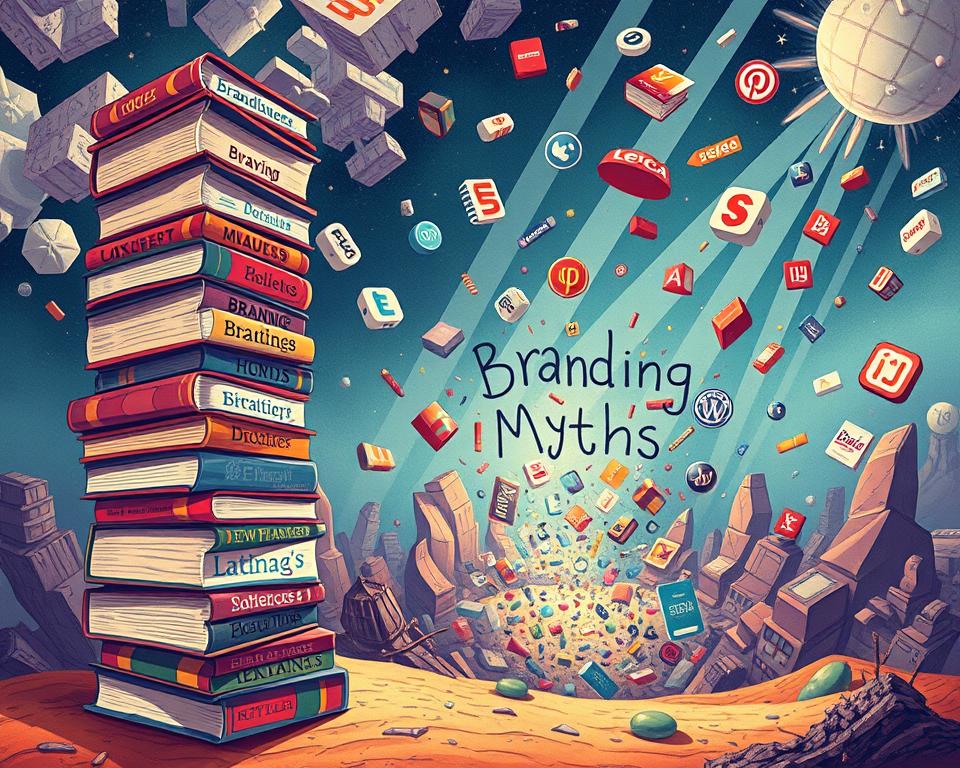Oglasi
how to Branding in 2025 means more than a logo; it is a practical process that helps your business move from idea to rollout.
Are you ready to test a brand promise that actually connects?
In a market where social media and savvy customers amplify every message, you must define your identitet brenda and set clear guidelines. This guide shows a sensible strategy you can adapt, with steps that cover identity, assets, and governance so your company looks and sounds consistent across your website and channels.
You’ll get compact checklists, simple experiments, and measurement ideas that help you learn fast without overpromising results. Use small tests, gather evidence, and iterate; that will keep your brand relevant as your business grows.
Why branding still matters in 2025
A clear promise still separates trusted names from fleeting trends in today’s fast feeds. Your customers expect consistent experience across channels, and social media can amplify every lapse.
Oglasi
Delivering reliably matters more than chasing viral moments. When your brand keeps its word, you build trust that lasts through buying cycles and noisy media landscapes.
- Repeatable promise: Anchor efforts in a promise you can deliver daily.
- Identity and voice: Let brand identity and brand voice work together to make your business recognizable.
- People, processes, tech: Use clear guidelines, shared assets, and approvals so teams produce accurate work faster.
- Measure and learn: Test small, gather evidence, then refine strategy before wider rollout.
Across B2C and B2B, consistent signals build credibility and loyalty. Your values and documented guidelines reduce confusion and keep partners aligned. Treat this checklist as practical guidance you can adapt for your industry and resources.
Set your brand purpose, mission, and values
Your company needs a clear north star — a purpose that focuses decisions and limits distractions. A short, honest mission tells customers what you aim to do and the promise you keep.
Oglasi
Purpose matters when teams pick suppliers, design features, or set service standards. Look at Patagonia: a mission that guides product choices and public action.
- Write one crisp mission line that states what your business does and the customer promise.
- List 3–5 values that describe behavior and trade-offs your team will follow.
- Map purpose to decisions like sourcing, support levels, and product roadmaps.
Validate wording with internal stakeholders and document everything in your brand identity guidelines. Keep statements short and human, avoid vague clichés, and revisit them as you learn from customers and the market.
Research your target audience and competitors
Start by mapping who buys and why — clear audience signals cut wasted effort.
Market and audience insights come from simple, ethical research you can run this week. Search your product category, interview people in your network, and watch the social media accounts your audience follows. Use tools like Google Trends and lightweight surveys to spot language and habits that matter.
Competitive positioning
Map the market and list direct and indirect competitors. Document their claims, pricing, creative, and channels so you avoid me‑too messaging.
- Interview people in your audience to learn jobs‑to‑be‑done and their exact words.
- Listen on social media and use trend tools to find topics and hashtags that drive interest.
- Analyze buying journeys online and in stores to spot friction and improvement points.
- Define segments within your target audience and pick the ones you can serve best now.
Real‑world example
An example is Lemonade Dolls: they focused on an underserved group and built identity through inclusive imagery and products. That niche focus created authentic connection and clear positioning.
Validate findings with small tests before larger campaigns. Capture verbatim quotes for website copy, synthesize insights into a short creative brief, and run ethical pilots that respect privacy and consent.
Shape your brand positioning, voice, and personality
Clear positioning turns vague claims into a useful compass for every message you publish.
Positioning statement template and example
Use this template as your north star: “We offer [PRODUCT/SERVICE] for [TARGET MARKET] to [VALUE PROPOSITION]. Unlike [COMPETITION], we [KEY DIFFERENTIATOR].”
Primjer: “We offer online bookkeeping for independent freelancers to cut monthly admin time in half. Unlike generic accounting tools, we combine simple automation with human review.”
Define voice, tone, and personality
- Draft a one‑ to two‑line positioning statement that guides all messaging and creative choices.
- Pick three personality adjectives (for example: helpful, direct, reliable) and use them as a copy filter.
- Write do’s and don’ts for your brand voice and channel‑specific tone notes.
- Translate the statement into a short message house for site, ads, and sales materials.
- Test wording with a small target audience and store decisions in your brand identity guidelines.
Savjet: Revisit this strategy when the market or audience shifts so your identity stays useful and true.
Name, story, and slogan fundamentals
A great name starts a conversation and gives your company a clear point of entry for customers.
Naming choices and checks
Practical checks:
- Pick a name that is distinctive, pronounceable, and fits your market norms — consider invented words, metaphors, acronyms, or portmanteaus as options.
- Verify domain and social handle availability and run a basic trademark screen before deep commitment.
- Pressure‑test with a small audience for clarity, unintended meanings, and recall.
Story that humanizes
Craft a short origin story that ties mission and values to real moments your customers face.
Use concrete details rather than grand claims. Share founder impulses, early challenges, or a simple value that shaped product choices. That makes your brend feel real and useful.
Slogans that stick
Create concise lines that echo your positioning. Try claims, metaphors, attitudes, or audience signals and test what people remember.
- Document the rationale for your name and slogan so future teams keep identity consistent.
- Plan legal review and basic availability checks as part of any final choice.
Design your visual identity and style guide
Good visual rules make every page, package, and post feel like it belongs to the same story. A compact system saves time and keeps your messaging clear across channels.
Color and typography
Limit your core palette to one or two main bojas with a small set of accents. Pick colors that pass contrast checks for black and white text so your website and packaging remain readable.
Choose two fonts: one for headings and one for body copy. Reserve decorative type for occasional use only, and set clear size and line‑height rules for marketing materials.
Imagery rules and graphic elements
Define photo mood, lighting, framing, and any filters so images feel cohesive. Give examples of acceptable shots and a handful of banned looks.
Specify reusable elements and motion rules that add recognition without clutter. Limit patterns and icons so layouts stay clean and fast.
Brand guidelines as a living system
Create a concise guide that documents logo usage, color codes, typography, spacing, and voice. Include correct and incorrect examples and file specs for print and digital.
- Version your smjernice and update them as you learn.
- Pilot changes on a few pages of your website before scaling.
- Align asset formats so non‑designers can apply identity across packaging and campaigns.
Logo and brand assets that scale
A compact logo system keeps your mark readable from a browser tab to a product label.
Plan for multiple mark types so your identity works in every context. Use a primary wordmark plus simplified variants: lettermarks, icons, emblems, mascots, and abstract marks. Prepare tiny versions for favicons and social avatars that remain distinct at small sizes.
Decide on production paths that match your company’s budget and skills. You can iterate with in‑house tools like simple editors or hire a specialist for a polished system. Avoid one‑size‑fits‑all tools; focus on clarity and distinctiveness.
Practical asset rules
- Varijante: Primary logo plus simplified marks that read at favicon and avatar sizes.
- Formats: Package SVG, PNG, and PDF in RGB and CMYK for website and packaging use.
- Guidelines: Define protected space, minimum sizes, incorrect uses, and versioning.
- Templates: Create a small set for headers, avatars, email signatures, and deck covers.
- Test and review: Check legibility on mobile, mockups, and real materials; plan periodic reviews.
how to Branding across channels: website, social, packaging, and offline
Your identity must travel well—from website pages to store shelves—without losing meaning.
Keep a few rules sacred: logo spacing, color hierarchy, and tone. Those invariants let you adapt layouts and formats while staying recognizable.
Set website patterns for navigation, CTAs, and imagery that match your marketing materials. Then adapt creative for social media formats so visuals and messages stay familiar across short videos, stories, and paid media.
- Channel matrix: list required assets, specs, and owners for each touchpoint.
- Prioritize: update the few products and pages that drive most impact, and run small pilots there first.
- Packaging and retail: translate look and voice into labels, signs, and displays so customers see a seamless experience.
- Teams: give ready assets and short briefs to reduce one-off interpretations.
Measure results after changes. Track clarity, recall, and conversions so you can confirm improvements. Prepare offline event kits—banners, badges, and leave‑behinds—that match digital identity, and revisit your playbook quarterly to capture learning and refine standards across your business.
Governance, processes, and technology for consistency
Centralized governance stops drift and keeps your brand usable across countries and channels. Set clear rules so everyone knows which assets are current and when exceptions are allowed.
Style guides, templates, and approvals
Create a short approval workflow so high-visibility materials get quick, consistent reviews. Publish simple smjernice that list reviewers, timetables, and escalation steps.
- Set an intake form that routes requests and captures legal needs.
- Publish SLAs that balance speed with quality for common marketing tasks.
- Provide on-brand templates for decks, one-pagers, and proposals.
Asset access and automation
Build a brand hub with the latest logos, fonts, copy blocks, and disclaimers. Use integrations and tools that plug into office suites so employees always use current files.
Ethical automation helps distribute updates without removing local control. Define versioning rules and clear file names so outdated materials stop circulating.
Enterprise example and change management
Large organizations see big wins: ERM cut formatting time by 75%, Tietoevry centralized assets for over 100,000 on‑brand documents, and Coloplast pushed refreshed files to 50+ countries.
- Train your teams on when to adapt locally and when to escalate exceptions.
- Use dashboards and quarterly metrics to refine your strategija and resource allocation.
- Choose tools that embed the guidelines into daily workflows, reducing guesswork.
Takeaway: you’ll cut errors and speed delivery by combining clear approvals, a single asset hub, and automated distribution. That approach protects identity while giving local team flexibility.
Measure and improve: analytics for brand health
Start with a compact measurement plan that matches your stage and resources. Pick three sightlines: visibility, perception, and loyalty. Keep metrics simple so your teams can act on them each month.

Awareness and engagement
Track website traffic, branded search volume, and social media engagement. Those signals show whether your identity reaches the right audience and if content resonates.
Perception and loyalty
Run short surveys and read reviews to capture sentiment. Monitor retention, repeat purchases, and referral counts as direct measures of loyalty and value creation.
Social listening and alerts
Use Google Alerts and social listening tools to capture mentions and sentiment shifts in real time. Set simple thresholds that trigger a review when volume or tone changes.
Iterate with evidence
Test small—A/B copy, visuals, or offers—and scale changes that improve metrics. Segment results by target and use cohort analysis to separate genuine brand movement from promotions or seasonality.
- Define KPIs for awareness, perception, and loyalty that match your market and resources.
- Build a dashboard and review it monthly with teams so everyone aligns on next steps.
- Document learnings and update your playbook so improvements stick across the organization.
Zaključak
Small, deliberate choices create clarity that customers notice. Treat the checklist as a practical map: it helps you create brand foundations and scale execution without overreach.
Test small, gather reliable data, and iterate. Keep strategy and values front and center so your team can make consistent decisions that improve the customer experience.
Document your identity and visual identity rules so future work stays efficient. Invest in simple systems that let your team produce consistent work with less rework.
Branding is an ongoing part of your business. Revisit this plan periodically, empower teammates, and focus on creating real value rather than chasing trends. For a short, practical follow-up, read this brief conclusion.



